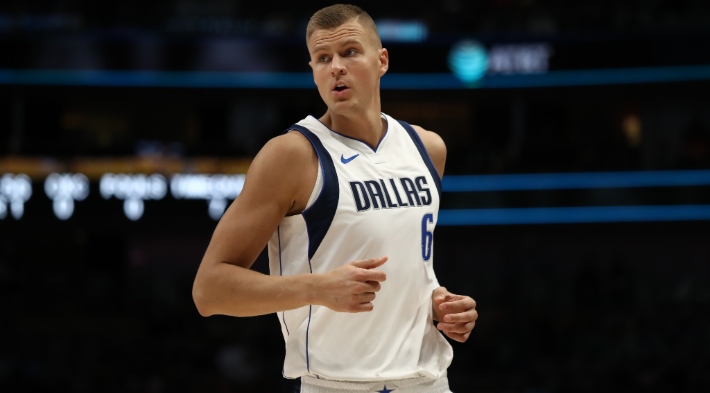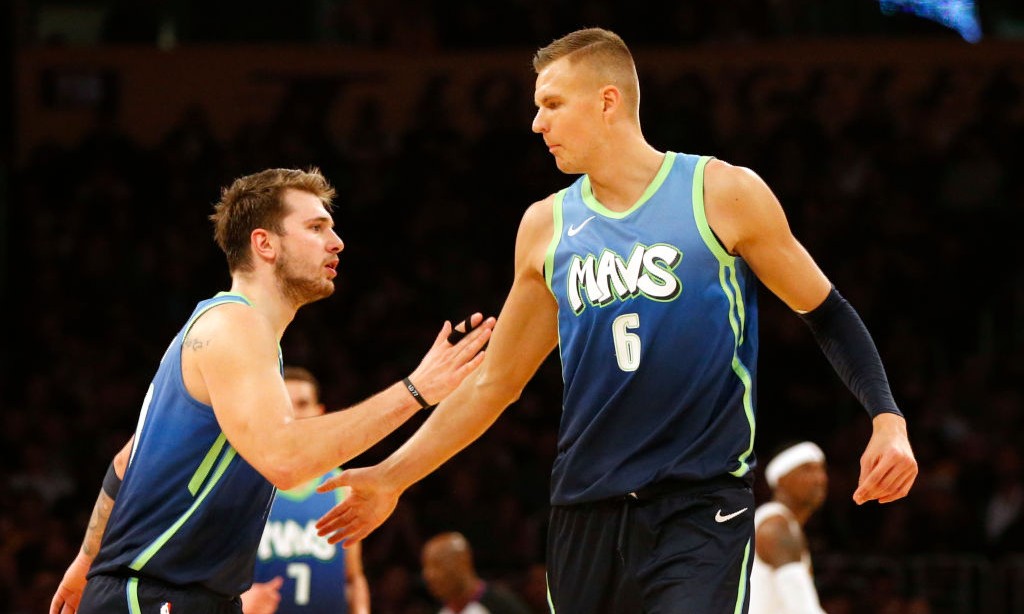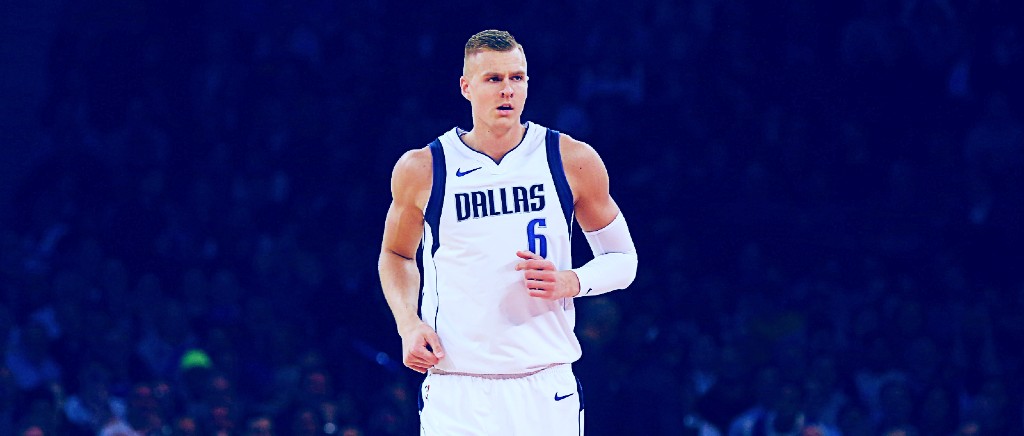When the name “Kristaps Porzingis” started popping up on mocks and big boards prior to the 2015 NBA Draft, there was plenty of confusion about who or what it was referring to. The pre-draft workout videos that emerged of the spindly 7’3 Latvian wunderkind only raised more pointed questions.
Would the Knicks really squander a top-five pick on a largely-unknown international prospect who looked like he might get swept away by a strong gust of wind? Was he destined to become the next Shawn Bradley, poster fodder extraordinaire for the league’s high-flying trophy hunters? Or would he be one of those dreaded draft-and-stash projects that fades into European obscurity?
The Knicks contingent at Barclays Center certainly feared the worst when Adam Silver announced his name on draft night. It was enough to send one young fan spiraling prematurely into the existential nightmare void that is long-suffering sports fandom. But a funny thing ended up happening: Porzingis quickly put those fears to rest.
The minute he stepped on the court, he was good at everything, with no caveats adjusting for his size. At 7’3 with a colossal wingspan, he could dribble, shoot from distance, block shots, and move laterally without shattering into a million pieces. With the direction the center position had been headed, it was as if he’d stepped right out of an evolutionary tide pool. Kevin Durant would eventually come up with a better designation, The Unicorn, a nickname that would literally mythologize him.
But because we’re talking about the Knicks, Porzingis and his immeasurable talent got off to a sputtering start. Carmelo Anthony was still the main attraction in New York when Porzingis first arrived, and yielding the spotlight to a potential usurper has never been something he’s handled with finesse. Beyond that, it was business as usual for the Knicks: lots of losing, administrative upheaval and incompetence, a murky vision, and an ongoing inability to attract star talent. Still, Porzingis made Knicks fans cautiously optimistic. By his third season, he was averaging 22.7 points, 6.6 rebounds, and 2.4 blocks per game on 39.5 percent shooting from downtown and earned his first All-Star selection. He was just coming into his own when disaster struck in the form a torn ACL that sidelined him for the next year and a half.
Last October, in the midst of his recovery, the team declined to offer him a rookie extension. Porzingis responded by demanding a trade, threatening to return to Europe if the organization failed to get a deal done before the February deadline.

There’s a lot to unpack when it comes to any discussion about Kristaps Porzingis. When the Knicks sent him to Dallas at the trade deadline last season, they tried to package it as if they were unloading someone with considerable baggage, but mostly it was just the latest in a long string of front office mismanagement. Still, there are unresolved rape allegations against Porzingis that cloud his off-court future, and there are still plenty of lingering questions about his post-injury outlook.
When the Mavs dealt for Porzingis, they hoped to create a dynamic pairing with Luka Doncic, the type of inside-outside combination that could wreak havoc on the league. There was, however, considerable risk attached, even if their ceiling is high. Historically, major knee injuries like a torn ACL have been career-altering for many players his size. Just a year-and-a-half later, it’s still too soon to tell whether Porzingis will regain the type of agility that made him such a unique talent.
Fortunately, the shooting touch is still there, albeit at a less efficient clip than his New York days. His 33.8 percent from three is a dip from the 39.1 percent he was converting before his injury, but the circumstances have also changed, in terms of both his usage rate and how he’s being deployed. In many ways, Doncic’s emergence has relieved much of the pressure Porzingis would’ve faced had he been expected to carry a team like he did in New York. As a result, his scoring has dipped from 22.7 points per game to 16.4, but so has his overall field goal efficiency, which has dropped from 43.9 to 39.8 this season.
None of this is surprising, given just how long it takes to recover from that type of injury. It certainly doesn’t hurt that the Mavericks are winning as Porzingis tries to find his footing. Dallas is 16-7 on the season, which is good for third in the West, just behind the two L.A. teams. In the process, Doncic is shattering all sorts of records for a player his age.

The relationship between Doncic and Porzingis is more symbiotic than it might appear. Porzingis is still a viable threat from outside despite his flagging efficiency, and the way he spaces the floor has afforded Doncic even more room to run roughshod over opposing defenses. Porzingis has been his most effective in catch-and-shoot situations, faring much worse when it comes to putting the ball on the floor and taking shots off the dribble. That’s to be expected, given the way his quickness and lateral movement has declined since the injury, and the Mavs are doing their best to mitigate that by putting him in more spot-up situations.
It’s a role reversal that’s required both a physical and mental adjustment on Porzingis’ part, as he admitted to Shams Charania of The Athletic recently. Having grown accustomed to having the ball in his hands and being able to leverage his size in the paint, transforming into Doncic’s pick-and-roll partner wasn’t something that came naturally to him, but it was his buy-in from the very beginning that has been driving their early-season success. Porzingis understood this when he signed that $158 million max contract last summer.
He also understood that, as he worked to get his rhythm back on offense, he could still make an impact on the other end. There was no better example of this than his seven-point outing against the Pelicans last week where he went 2-for-11 from the field but finished with five blocks in a Dallas win. Just a week prior, he’d become the fastest player to reach 300 three-pointers and 400 blocked shots.
As in previous years, Porzingis is averaging around two blocks per game and anchoring the Mavs’ front line. But he’s also a versatile perimeter defender who can switch in the pick-and-roll and bother opponents with his length. He’s only going to get better in that department as he continues to regain his ability — and confidence — in his lateral movement. He’s also posting a career high in rebounds at 8.7 per game, committing to his role on the defensive end in every way, including on the glass.
Doncic’s incredible play has allowed Dallas the luxury of bringing Porzingis along slowly and methodically. The key for Porzingis will be maintaining a certain level of patience. It’s also requiring teammates, coaches, and even owner Mark Cuban to put some effort toward ego management, i.e. continually emphasizing the narrative that Porzingis’ current contributions are making a meaningful impact on the team’s success. After all, it’s true.
Yet, even though the Mavs are way ahead of schedule, they’ll eventually need Porzingis to play a bit closer to his pre-injury peak if they are truly going to contend in the West, particularly against loaded teams like the Lakers and Clippers. Doncic is carrying a tremendous load, and the opportunities will be there for Porzingis. From that perspective, it’s good news that he isn’t satisfied with where he is right now, regardless of the Mavs’ record.
It’s going to take time, but he’s mostly trending in the right direction, despite the inconsistencies. The partnership is working, and the Mavs are only going to get better if Porzingis continues to make his slow climb back to something resembling All-Star form.







